Best Pumpkin Pie Ever, Baked by Kyle Gallup
Posted yesterday at HonouraryCanadian.com, sister blog to this one, a brief post with a photo of some amazing baking done by my wife Kyle Gallup, an artist in paints and pastry. 
Posted yesterday at HonouraryCanadian.com, sister blog to this one, a brief post with a photo of some amazing baking done by my wife Kyle Gallup, an artist in paints and pastry. 
 Last June at BEA I picked up an advance reading copy of the forthcoming book Chaser: Unlocking the Genius of the Dog Who Knows a Thousand Words by psychology professor John W. Pilley, then made it my #FridayReads one week in August. I’m writing again about it now because Shelf Awareness posted a charming video trailer for the book today. This amazing book on the science of the canine mind will officially be published October 29.
Last June at BEA I picked up an advance reading copy of the forthcoming book Chaser: Unlocking the Genius of the Dog Who Knows a Thousand Words by psychology professor John W. Pilley, then made it my #FridayReads one week in August. I’m writing again about it now because Shelf Awareness posted a charming video trailer for the book today. This amazing book on the science of the canine mind will officially be published October 29.
#FridayReads AB Guthrie’s western BIG SKY abt mountain man Boone Caudill. Cover of copy given me by my late brother: pic.twitter.com/7WqqYY1l8O
— Philip Turner (@philipsturner) October 18, 2013
Today my #FridayReads is a re-read, prompted by a book discussion during the past week about novels of the American West. It all began seven days ago, with last week’s post in this vein: “#FridayReads, Oct 11–Ben Urwand’s The Collaboration: Hollywood’s Pact with Hitler & Anne Hillerman’s Spider Woman’s Daughter.” I had shared the post in my social networks, including with authors Urwand and Hillerman, and was delighted mid-week when I heard from Ms. Hillerman with a thank you for my piece.* Her new book–a revival of the mystery series written over several decades by her late father, the mystery master Tony Hillerman–though only on sale about a week, had quickly leapt on to the NY Times bestseller list. On the Wordharvest Writers Workshop Facebook page, Anne had linked to an article about books and asked this question:
Craig Johnson’s work [the Sheriff Longmire series] was the subject of an article about Western archetypes. The writer praises Johnson’s Walt Longmire character as a perfect example of the Western hero. Who do you think is the quintessential Western hero in fiction?
In response, I got up from my desk to dig out my copy of a favorite Western novel, The Big Sky, by A.B. Guthrie, Jr., a terrific novel set in the old West. I needed to check the year of publication, to include it in my answer, so I went over to a nearby bookcase where, though it’d been a long time since I took it off the shelf, I knew I’d find my old copy of Guthrie’s modern classic. There, residing between a New Directions edition of Lars Gustafsson’s The Death of a Beekeeper and a Dover Classics copy of H. Rider Haggard’s Ayesha. I quickly found the copyright page in the Guthrie–1947. Then my hand landed between the cover and the book’s first leaf, discovering there an inscription. Hmm, I didn’t remember this book had one. Looking at it, I realized it was to me, written by my brother Joel, who died suddenly in December 2009, age 58. Dated 9/22/72, on what would’ve been my 18th birthday, the note was written in Joel’s still-familiar hand, a firm print that brought with it an instant evocation of his personality and character. Joel wrote:
Phil– 9/22/72
You will like this story and the following two, The Way West and These Thousand Hills. Do not ! read the foreword by Stegner until you finish The Big Sky; he gives everything away. Love, Joel
Over the years I’ve also noticed the way old samples of handwriting from my father Earl or mother Sylvia prompt a strong sense of them. They died respectively in 1992 and 2006. Though Earl’s been gone the longest, his handwriting–also in print, not script except for his signature–still carries all the sweetness of him. My mother’s less legible script is tremulous, bespeaking some nervousness when she sat down to write.
The Big Sky beautifully captures the era of the lone mountain man, as personified in pop culture by the 1972 Robert Redford film, Jeremiah Johnson, which was itself based on a novel, Mountain Man, by Idaho writer Vardis Fisher. Guthrie’s later novels, which Joel also recommended to me in his inscription, cover subsequent epochs–the wagon trains in The Way West and the advent of the first great ranch herds of cattle in These Thousand Hills. The three books are a proper trilogy, with each covering about a twenty-year period of American history. To Guthrie’s trilogy I will also add The Awakening Land Trilogy, a great series by Conrad Richter, made up of The Trees, The Field, The Town, again describing one arc of American history.
By the way, my answer to Anne Hillerman’s good question went like this:
I do like the literary character of Walt Longmire [also a good TV show], but to keep climbing higher up the pinnacle of literary greatness I’d go to A. B. Guthrie’s Boone Caudill from The Big Sky (1947). Also, from history, I want to put in a word for Hugh Glass, true life survivor of a grizzly bear mauling in the 1820s, who’s been a character in fiction as recently as 2001, when I edited Montana writer Michael Punke’s terrific novel The Revenant: A Novel of Revenge.
Thanks to Anne Hillerman, for prompting me to re-read A.B. Guthrie’s fine novel. Here are pictures I’ve taken of all the relevant books in this post. The links to the books above are all ‘live,’ and if clicked on will take you to Powell’s Books of Portland, OR, where you can buy any of them if you wish, with a fraction of the purchase price being returned to me for the upkeep of this website.
* Coincidentally, I also had a pleasant encounter with Ben Urwand, author of The Collaboration: Hollywood’s Pact with Hitler, when I heard him lecture last night at the Wiesenthal Center’s Museum of Tolerance, which I will write about in the week to come.
Eager to hear @JayneAnneOnly tonite on her new book QUIET DELL at the Strand. My blog on the novel-http://t.co/sOmlaN2gVd @ScribnerBooks
— Philip Turner (@philipsturner) October 15, 2013
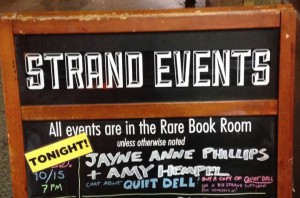 Among the best books that I discovered during Book Expo America (BEA) last June, was Quiet Dell by Jayne Anne Phillips. In August I had made this mesmerizing novel–set in 1930s West Virginia, drawn from the annals of a notorious true crime–one of my #FridayReads and have written about it a few times since, including in a post about what I’ve dubbed “documentary fiction.” Early newspaper reviews have been great, including praise by the Tampa Bay Times Book Editor Colette Bancroft (“Sometimes eerie and dreamlike, others grippingly tense, yet warmly human, always written with beauty and emotional power, Quiet Dell is a virtuoso performance by a highly original writer.”); Amy Driscoll in the Miami Herald (“A smart combination of true crime, history and fiction tied together with Phillips’ seamlessly elegant writing….Phillips writes with a tone that is sometimes impressionistic, sometimes hard-edged. It’s a linguistic balancing act that results in an emotional chiaroscuro.”); and Celia McGee in the Chicago Tribune (“If the factual underpinnings of this latest novel are unusual for Phillips, her ability to transform them into a fictionalized narrative place her at the top of her form. Phillips has…create[d] a story both splendid and irreparably sad.”).
Among the best books that I discovered during Book Expo America (BEA) last June, was Quiet Dell by Jayne Anne Phillips. In August I had made this mesmerizing novel–set in 1930s West Virginia, drawn from the annals of a notorious true crime–one of my #FridayReads and have written about it a few times since, including in a post about what I’ve dubbed “documentary fiction.” Early newspaper reviews have been great, including praise by the Tampa Bay Times Book Editor Colette Bancroft (“Sometimes eerie and dreamlike, others grippingly tense, yet warmly human, always written with beauty and emotional power, Quiet Dell is a virtuoso performance by a highly original writer.”); Amy Driscoll in the Miami Herald (“A smart combination of true crime, history and fiction tied together with Phillips’ seamlessly elegant writing….Phillips writes with a tone that is sometimes impressionistic, sometimes hard-edged. It’s a linguistic balancing act that results in an emotional chiaroscuro.”); and Celia McGee in the Chicago Tribune (“If the factual underpinnings of this latest novel are unusual for Phillips, her ability to transform them into a fictionalized narrative place her at the top of her form. Phillips has…create[d] a story both splendid and irreparably sad.”).
The book was officially published yesterday, and I was excited to attend Phillips’ first reading and signing for it last night. The event drew a big crowd to the Rare Book Room at the Strand Bookstore. Phillips read three sections from the novel, introducing nine-year old Annabel Eicher, who has a lingering presence in the narrative, even after she and her family are taken off by their killer, under the guise of her widowed mother’s suitor; a dog with the Victorian name, Duty, a kind of avenger on behalf of the Eicher family that had adopted the loyal Boston Terrier (the AP review dubs him “one of fiction’s best dogs); and journalist Emily Thornhill, who reports on the criminal case and ensuing trial for a Chicago newspaper. She was a careful reader of her own prose, with appropriate weight given to key passages.
Phillips left the lectern and joined writer Amy Hempel, seated in a chair at the front of the room. Hempel began their conversation by asking who among the audience were readers of the True Crime genre. A number of hands went up, including mine. Hempel continued, asking Phillips about her decision not to dwell in the sensational aspects of the crime that is the basis of the book, and instead focus on imagining the lives of the Eicher family before they became the victims that history has remembered them as, at least until Quiet Dell. Hempel added that Phillips also might tell the audience about the video book trailer (pasted in below) that has accompanied the book’s release.
Phillips responded, “I grew up in a little town and Quiet Dell was a tiny hamlet nearby of maybe 100 people. My family had been in West Virginia since the 1700s.” Her mother at just age six had been aware of the sensation that discovery of the crimes caused in the region. “Many thousands of people walked past the crime site. People almost made pilgrimages there.” She said, “almost everything in the book is based on fact” and the available historical record, “except for Emily [Thornhill]’s intuitions. . . . I feel a life is not defined by its brevity, but by its intensity and the idea behind fiction is too allow a reader to enter a life through a kind of complex empathy, to really feel that life. And, I think or I hope, that you feel each one of these children. There is a sense of adjacent dimensions, all the way through the book. From the very beginning, in the beautiful Christmas section, the reader is aware in ways the characters are not, of Annabel’s slightly strange pronouncements which people are accustomed to hearing from her, which actually do in some way foreshadow something what is going to happen and if it’s going to happen, what does that mean? That’s a real mystery.”
After about twenty-five minutes of conversation, Hempel asked her final question and the floor was opened to questions and comments from the audience. I raised my hand and first told Phillips how much I’d loved reading Quiet Dell. Thinking of “documentary fiction” as a new sort of genre, I added that we seem nowadays to live in an age of mashups in which creators borrow material from many sources, and that while she had been thinking about writing this book for many years, I was glad that it had come out now because it seemed almost as though the culture had matured to the point where collage-like works like this were more apt to be accepted and appreciated than they might have been at another time. Had I been smarter at that moment, I would have recalled that as early as the 1940s John Dos Passos was using an assemblage technique for his USA Trilogy, but that aside, Phillips had a great response: “Well, I hope you’re right. To me the fascinating thing was that I was inside this invented world, and yet in the snippets of these articles there were the names of my characters so it kept underscoring the reality all the way through. And the photographs, it was just an incredible boon, to have this backbone of reality and yet all the meaning was really inside the fiction, that had to be invented.”
Among the questions that followed was one about Phillips’ writing process, to which she responded that due to her full time job at Rutgers University (where she’s Director of the MFA Program in Creative Writing), she finds she can only write full-time during the summer. It occurred to me, I bet she’s a great teacher, too, as well as a superb fiction writer. Standing in line later, I reintroduced myself to Phillips (we had met briefly last spring at the NBCC awards and in the summer at BEA) and had her sign two of her earlier books I bought that the Strand had on hand, Lark & Termite and Black Tickets. Below is the video trailer and photos from last night’s inspiring literary event.
 Hundreds of New Yorkers found their way to Fort Washington Park yesterday, underneath the George Washington Bridge, aka the Great Gray Bridge, for the 21st Little Red Lighthouse Fall Festival, co-sponsored by the NYC Parks Dept and the New York Restoration Project (NYRP). The latter is Bette Midler’s organization, aka MillionTrees.org. I had no idea the festival’s been going on every year since 1992! I biked up there and had a fun couple of hours, marveling at the big crowd, including many families with young children, all enjoying a great NYC landmark, one that I’ve cherished a long time, though usually alongside only just a few other visitors to the site, not dozens.
Hundreds of New Yorkers found their way to Fort Washington Park yesterday, underneath the George Washington Bridge, aka the Great Gray Bridge, for the 21st Little Red Lighthouse Fall Festival, co-sponsored by the NYC Parks Dept and the New York Restoration Project (NYRP). The latter is Bette Midler’s organization, aka MillionTrees.org. I had no idea the festival’s been going on every year since 1992! I biked up there and had a fun couple of hours, marveling at the big crowd, including many families with young children, all enjoying a great NYC landmark, one that I’ve cherished a long time, though usually alongside only just a few other visitors to the site, not dozens.
As is the custom on the second Saturday of each month from May-October, the little red lighthouse was also opened to visitors yesterday, and long lines of people waited a turn to get inside and see for themselves this treasure of naval architecture and maritime history. I had toured the lighthouse and taken many photographs in August and September, and so happily left it to other visitors yesterday. Booths at the festival included such exhibits as Urban Park Rangers (a career I’m sure I would enjoy); NYRP and their Million Trees initiative; and such local businesses in Washington Heights, the neighborhood adjoining Fort Washington Park, as Word Up Bookstore and Storefront Science. Festival organizers had also printed poster-sized reproductions of Lynd Ward’s art from Hildegarde H. Swift’s classic children’s book The Little Red Lighthouse and the Great Gray Bridge, and from a stage that earlier sported a quite good cajun & roots band called The Amigos, the book was read aloud with help from teenagers from BuildOn.org and an NYC Parks Dept official. I was amused when the official announced the youth group as Move On, which sounded odd–it seemed a bit far afield for MoveOn.org–and the kids quickly corrected her, saying, “We’re from Build On!”
For a finale, an FDNY fireboat cruised up the Hudson, drifted close to the shoreline and then turned about so spectators could see the vessel from every angle. And then the crew provided a great water exhibition, shooting great arcs of water from the boat’s hoses and spouts, creating transparent scrims of water shimmering against the blue sky and bright sunshine. It was a splendid sight and an enjoyable festival. Below are my photographs from the delightful day.Please click here to see all photos.
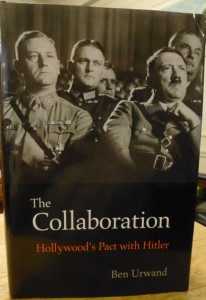 #FridayReads, Oct 11–Ben Urwand’s The Collaboration: Hollywood’s Pact with Hitler & Anne Hillerman’s Spider Woman’s Daughter, a new installment in the long-running Joe Leaphorn and Jim Chee mystery series established by her late father, the mystery master Tony Hillerman.
#FridayReads, Oct 11–Ben Urwand’s The Collaboration: Hollywood’s Pact with Hitler & Anne Hillerman’s Spider Woman’s Daughter, a new installment in the long-running Joe Leaphorn and Jim Chee mystery series established by her late father, the mystery master Tony Hillerman.
—
Notwithstanding the controversy I’ve reported on earlier that’s greeted publication of The Collaboration, which I had made part of my #FridayReads a few weeks ago, I have been continuing to methodically read it, even while still reading fiction. It’s ironic about all the hubbub, because I am finding it so far, about 80 pages in, an unsensational, moderately engrossing and well-documented account.
The narrative opens by examining “All Quiet on the Western Front,” the 1930 WWI drama released by Universal Pictures that to German officials, dangerously advocated pacifism while also showing cowardice and dishonorable conduct by their troops. The government, two years before Hitler was to win power, viewed it as a threat to to the nation, and sought to have whole passages of the film cut, scenes changed, and dialogue rewritten. They threatened to remove it from all German screens, and to make it harder for other American pictures to be exhibited in Germany.
After this key opening example, the book becomes a chronicle of the willing cooperation of some American film industry executives–who along with a number of American functionaries and bureaucrats, and at least one Jewish communal organization, the Los Angeles branch of the Anti-Defamation League–worked to suppress American-made movies being produced about contemporary Germany. Some of this suppression was triggered by German trade officials who after the Great War’s ignominy zealously attacked films from foreign countries that seemed to hyper-sensitive German governments (even preceding Nazi rule) prejudicial against their country and “damaging to their reputation abroad,” or potentially “demoralizing to morale” at home, as they put it, as with “All Quiet on the Western Front.” Hitler was an enthusiast of cinema and theatrical performances of all kinds, as earlier shown in a book I edited and published, Ibsen and Hitler: The Playwright, the Plagiarist, and the Plot for the Third Reich. Once Hitler was in power, with hyper-awareness of both the positive and the damaging effects of propaganda, he focused his regime on how messages might be spread by movies. With that, the Nazis began even more aggressively lobbying foreign filmmakers to alter the scripts of movies in production, or edit and recut ones already being exhibited on German screens.
For a rundown of the controversy surrounding the book and the overheated things some of its critics have said about it, please see my recent post, Questioning the Critical Reaction to Ben Urwand’s “The Collaboration: Hollywood’s Pact w/Hitler”
A Second #FridayReads, Spider Woman’s Daughter, Anne Hillerman’s new Joe Leaphorn and Jim Chee Mystery Novel
While reading The Collaboration, I am intercutting it with Anne Hillerman’s Spider Woman’s Daughter. I’ve read and loved the Leaphorn and Chee series for years, and made his 1982 book Dark Wind one of my #FridayReads last year.
Tony died in 2008. About the revival of the series, Anne has written, “When I emerged from the worst of my grief after Dad’s death, I realized that I was also mourning the end of his mystery series. I missed those detectives [Leaphorn and Chee], and I especially regretted that Bernadette Manuelito would never get a book that put her in the spotlight. And then I thought: I could try writing Bernie’s book myself. . . .In addition to Tony Hillerman’s Landscape, I had written several other books, so I knew part of the challenge that faced me. I jotted down some ideas as a rough outline and got to work.”
I’m loving her new book. The protagonist, Bernadette, is a young police officer in Navajo Country, married to Jim Chee, who learned how to be a cop under the tutelage of Joe Leaphorn, wise man of the tribal police force. She witnesses a startling assault on a fellow cop in the book’s opening chapters, which forces her to the sidelines of an important investigation. Despite her chief’s order to drop any involvement with the case, she continues trying to riddle it out, even while Chee and her fellow officers pursue every lead. Bernie’s unauthorized efforts take her all across the dramatic landscape of Navajo Country, speaking with people who may help her understand what’s really going on. Just as in Tony’s books, the sense of place and people is indelible.
Coincidentally, over the summer, working as literary agent for author J. Michael Orenduff, I licensed his 6-book POT THIEF mystery series to Open Road Integrated Media who will publish them in ebook and print editions in January 2014. The books are are set in and around Albuquerque, New Mexico, and feature dealer in Native American pottery Hubie Schutz. They’re titled The Pot Thief Who Studied Pythagoras, The Pot Thief Who Studied Ptolemy, The Pot Thief Who Studied Einstein, The Pot Thief Who Studied Escoffier, The Pot Thief Who Studied D. H. Lawrence, and The Pot Thief Who Studied Billy the Kid. When not digging in the desert for ancient pots, or crafting copies of artifacts with his own hands, Hubie’s usually absorbed in reading a classic text. In their earlier editions, the POT THIEF books won numerous awards and raves from mystery readers, including this one from Anne Hillerman herself: “I inhaled this book. Witty, well-crafted and filled with unexpected plot turns, The Pot Thief Who Studied Billy the Kid will delight J. Michael Orenduff’s many fans—and win him new ones.”
It’s a small world out there for mystery writers and readers and I’m really excited that Anne Hillerman’s brought back her father’s great characters, and that fans of the Leaphorn and Chee books will soon be able to discover and enjoy the POT THIEF mysteries.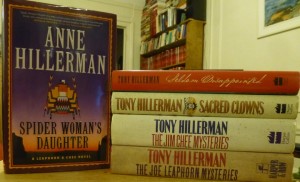
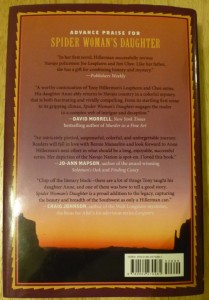
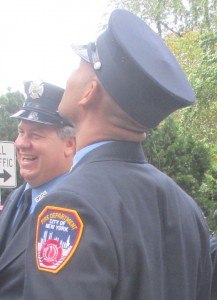 As I began my workday this morning, I heard the mellifluous sound of massed bagpipes and knew that today must be a special day in the city for firefighters. My Manhattan neighborhood is home to the city’s Fireman’s Memorial, at 100TH Street and Riverside Drive. It’s one of the city’s sublime spots. When tragic events occur, or when anniversaries of them come round, like those for 9/11, hundreds of firefighters in full dress uniforms flood the area for remembrances that include fire engines and chief’s cars parked all akimbo on nearby streets, and dozens of bagpipers and drummers all marching in unison. With the sound of bagpipes drifting in my window, I went out for a walk to observe the ceremony.
As I began my workday this morning, I heard the mellifluous sound of massed bagpipes and knew that today must be a special day in the city for firefighters. My Manhattan neighborhood is home to the city’s Fireman’s Memorial, at 100TH Street and Riverside Drive. It’s one of the city’s sublime spots. When tragic events occur, or when anniversaries of them come round, like those for 9/11, hundreds of firefighters in full dress uniforms flood the area for remembrances that include fire engines and chief’s cars parked all akimbo on nearby streets, and dozens of bagpipers and drummers all marching in unison. With the sound of bagpipes drifting in my window, I went out for a walk to observe the ceremony.
October 9th–far as I knew, today was no anniversary of a specific incident. I asked one firefighter about the occasion and he confirmed what I suspected: this day is marked on the civic calendar as a general remembrance for all firefighters who’ve ever died in the line of duty, stretching all the way back through more than 250 years of New York history. Here are some pictures I took this morning, and one that I took of a child at the Fireman’s Memorial last month on 9/11, the last time that hundreds of firefighters made a pilgrimage to my neighborhood. Please click here to see all pictures.
Just entered my name w/details of my indie editorial practice in @GalleyCat's handy new directory of editorial pros. http://t.co/1xZ5vvc0cr
— Philip Turner (@philipsturner) October 9, 2013
Galleycat.com is the book industry blog for the collection of media blogs that come under the rubric of mediabistro.com. It’s a valuable source of daily information on the book biz. I was glad when I saw galleycat had recently started a Google Docs directory of independent editors. I registered on it this morning. The simple sign-up asked for areas of concentration, notable books I’ve worked on, what kind of editing I do, and the url for the Philip Turner Book Productions page on this website. I’m glad to be part of this directory where authors, agents, and publishers seeking editorial help can learn about my consultancy.
